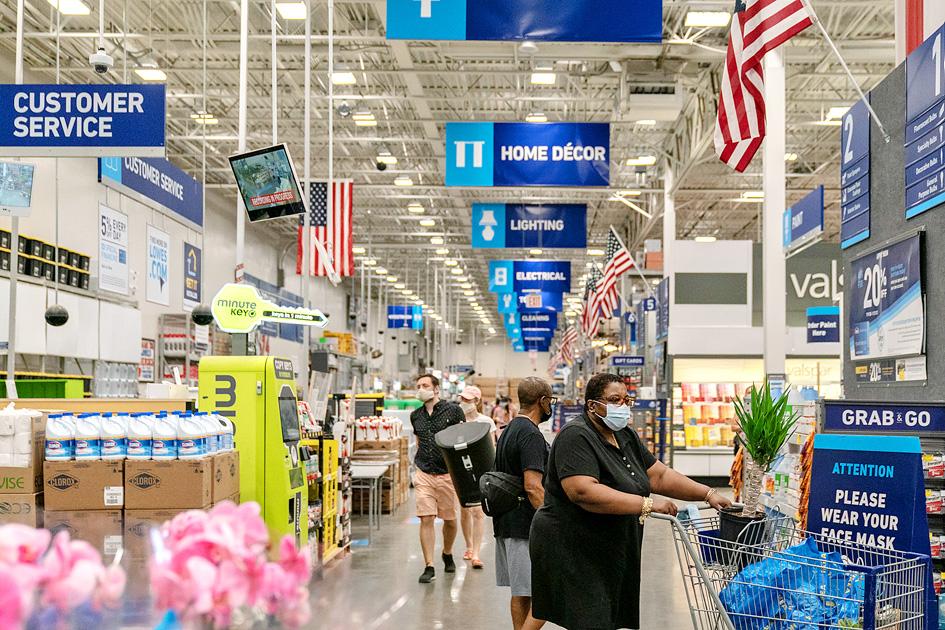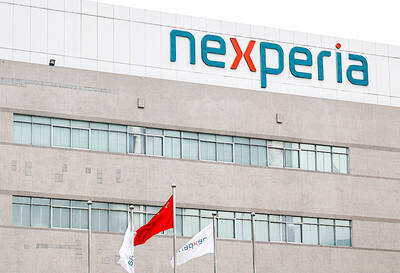Many retailers have been caught off-guard by COVID-19 restrictions and shifting consumer habits, but do-it-yourself (DIY) stores are enjoying a boom as people spend money on their homes and gardens.
A report by consulting group McKinsey & Co found that faced with a prolonged period of financial uncertainty due to the COVID-19 pandemic, consumers “intend to continue shifting their spending largely to essentials ... and cutting back on most discretionary categories.”
Consumers worldwide are cutting back on clothing and shoes, but spending more to improve their homes, the report said.

Photo: Bloomberg
In the UK, the sector has helped consumer spending overall to rebound to a level higher than before the pandemic hit.
“Spending for home improvements continued to rise in August as sales volumes within household goods stores increased by 9.9 percent when compared with February,” the UK Office for National Statistics said.
This should not come as a surprise, as people are spending more time at home, and even when not under lockdown, many people are working from home or have fewer public activities to participate in, the report said.
A survey carried out in 20 countries by consulting firm Accenture Ltd found that over two-thirds of respondents expect most of their social activities to take place at their home or that of friends.
The unease that many people feel in public spaces might push a lasting shift toward people spending more time at home, Accenture said, calling it a “decade of the home.”
Many Germans have used the downtime during the COVID-19 lockdown to “repair, refurbish and decorate their homes,” the country’s BHB trade association for home improvement, building and gardening said in a report.
Sales in the sector rose by 15.6 percent year-on-year to nearly 12 billion euros (US$139.58 billion) over the first half of this year, boosted by many DIY stores and garden centers being allowed to stay open during virus lockdowns.
Paint and painting accessories proved most popular, with sales climbing by 37.6 percent, BHB said, adding that garden furniture also saw a 21 percent sales jump, it said.
DIY retailers have been reporting surging sales.
Lowe’s Co, a major DIY chain in the US, saw sales rise 34.2 percent in its second quarter that ended on July 31 — a period when restrictions were still in place in some US states.
“Sales were driven by a consumer focus on the home, core repair and maintenance activities, and wallet share shift away from other discretionary spending,” Lowe’s chief executive Marvin Ellison said when announcing the results.
Kingfisher PLC, which has several DIY and home furnishing chains in France, the UK and Ireland, said that after an initial dip, sales quickly recovered and are still rising.
“The COVID-19 crisis touched our sales in the first quarter, but we saw a strong rebound in the second, a trend which is continuing in the third quarter at all of our chains and in all segments,” Kingfisher chief executive Thierry Garnier said.
Consumers have shifted a lot of their buying to online stores, a trend that is helping ManoMano SAS, an online-only French DIY retailer.
“In February, we were at 50 million euros in sales volume and in April, we were at 200 million, so you see the acceleration,” ManoMano cofounder Christian Raisson said. “We’ll more than double the 620 million euros in sales we had last year.”

JITTERS: Nexperia has a 20 percent market share for chips powering simpler features such as window controls, and changing supply chains could take years European carmakers are looking into ways to scratch components made with parts from China, spooked by deepening geopolitical spats playing out through chipmaker Nexperia BV and Beijing’s export controls on rare earths. To protect operations from trade ructions, several automakers are pushing major suppliers to find permanent alternatives to Chinese semiconductors, people familiar with the matter said. The industry is considering broader changes to its supply chain to adapt to shifting geopolitics, Europe’s main suppliers lobby CLEPA head Matthias Zink said. “We had some indications already — questions like: ‘How can you supply me without this dependency on China?’” Zink, who also

Taiwan Semiconductor Manufacturing Co (TSMC, 台積電) received about NT$147 billion (US$4.71 billion) in subsidies from the US, Japanese, German and Chinese governments over the past two years for its global expansion. Financial data compiled by the world’s largest contract chipmaker showed the company secured NT$4.77 billion in subsidies from the governments in the third quarter, bringing the total for the first three quarters of the year to about NT$71.9 billion. Along with the NT$75.16 billion in financial aid TSMC received last year, the chipmaker obtained NT$147 billion in subsidies in almost two years, the data showed. The subsidies received by its subsidiaries —

At least US$50 million for the freedom of an Emirati sheikh: That is the king’s ransom paid two weeks ago to militants linked to al-Qaeda who are pushing to topple the Malian government and impose Islamic law. Alongside a crippling fuel blockade, the Group for the Support of Islam and Muslims (JNIM) has made kidnapping wealthy foreigners for a ransom a pillar of its strategy of “economic jihad.” Its goal: Oust the junta, which has struggled to contain Mali’s decade-long insurgency since taking power following back-to-back coups in 2020 and 2021, by scaring away investors and paralyzing the west African country’s economy.

The number of Taiwanese working in the US rose to a record high of 137,000 last year, driven largely by Taiwan Semiconductor Manufacturing Co’s (TSMC, 台積電) rapid overseas expansion, according to government data released yesterday. A total of 666,000 Taiwanese nationals were employed abroad last year, an increase of 45,000 from 2023 and the highest level since the COVID-19 pandemic, data from the Directorate-General of Budget, Accounting and Statistics (DGBAS) showed. Overseas employment had steadily increased between 2009 and 2019, peaking at 739,000, before plunging to 319,000 in 2021 amid US-China trade tensions, global supply chain shifts, reshoring by Taiwanese companies and